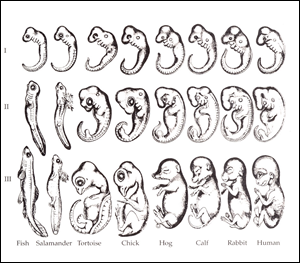The last item of “evidence” for evolution that we will consider is Embryology. As the name implies, this is the study of embryos. Evolutionists believe in the idea: “Ontogeny Recapitulates Phylogeny.” That means that the development of the embryo in the womb (for humans) retraces it’s entire evolutionary history.
 This notion began with Ernst Haeckel who made a number of detailed drawings of embryos in various stages of development. For example, at one stage, human embryos have an extension of the spine that looks like a tail. Since we supposedly evolved from ape-like ancestors which had tails as adults, our embryo “tails” are a throwback to those earlier ancestors. Also, human embryos have what look like gills. Evolutionists say that they point back further to the time when all land animals evolved from fish.
This notion began with Ernst Haeckel who made a number of detailed drawings of embryos in various stages of development. For example, at one stage, human embryos have an extension of the spine that looks like a tail. Since we supposedly evolved from ape-like ancestors which had tails as adults, our embryo “tails” are a throwback to those earlier ancestors. Also, human embryos have what look like gills. Evolutionists say that they point back further to the time when all land animals evolved from fish.
However, these are not leftovers from our ancient ancestors. The embryonic tail develops into our tail bone or coccyx. This structure is vitally important in our ability to stand or sit. The so-called gills are actually pouches which develop into part of our middle ear and at least three other structures which are vital in calcium regulation and immunity to disease in our bodies.
Later in his career, about 100 years ago, Haeckel admitted that he had altered some of his drawings to support his theory. Nevertheless, embryology is still used in modern textbooks to convince students that evolution is true. Next month we will begin looking at some evidence that supports creation.
– Bill Rogers
Originally printed in the Acton Faith Bible Church Pony Express. Vol. I, No. 07, October 2008.

